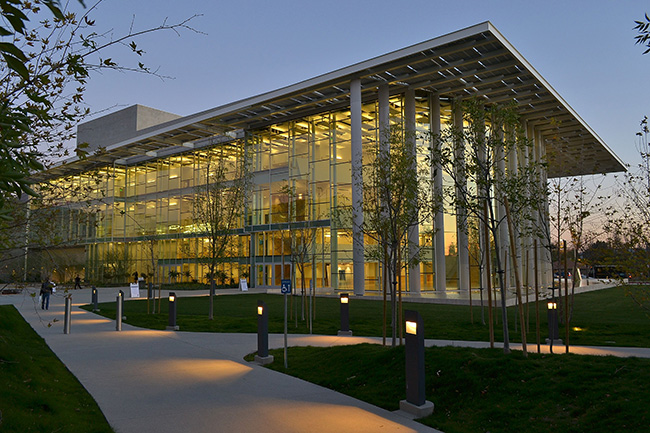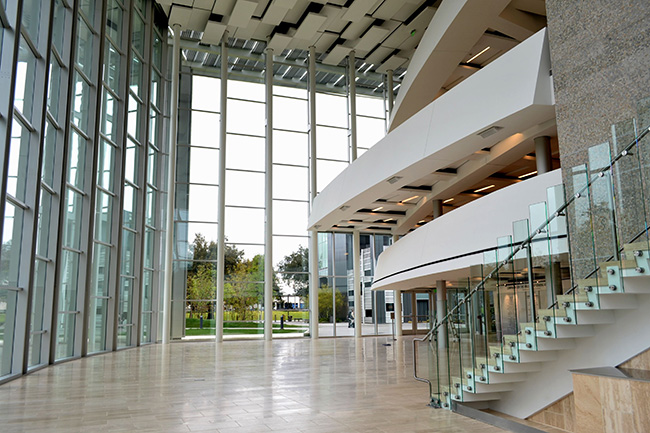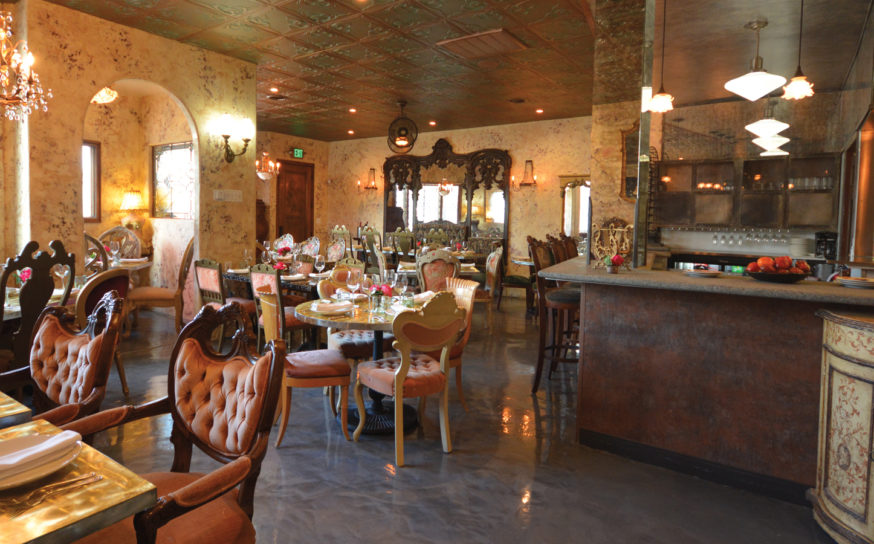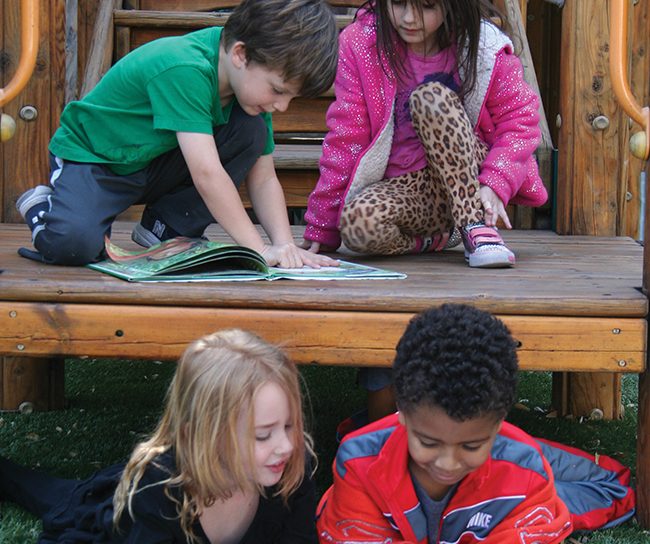
Green, Glistening & Gorgeous
The San Fernando Valley, filled with 1.7 million people and stretching 260 square miles from Burbank to Chatsworth, might be home to Disney and Warner Brothers, NBC and CBS, but it never had its own performing arts center. Until now.
-
CategoryPeople
The San Fernando Valley, filled with 1.7 million people and stretching 260 square miles from Burbank to Chatsworth, might be home to Disney and Warner Brothers, NBC and CBS, but it never had its own performing arts center. Until now.
Five years and $125 million dollars in the making, the Valley Performing Arts Center at California State University, Northridge is up and running. In fact, it’s midway through its debut season. The spring lineup featured a wide range of acts—from Roseanne Cash to the China Philharmonic Orchestra to An Evening with Patti LuPone & Mandy Patinkin, one of several sold-out performances. “We’re quite pleased,” says CSUN President Jolene Koester.
Perhaps no one is more excited about the new facility than the self-assured, smiling Koester. She envisioned the project when she came to CSUN 11 years ago. “We have a strong arts program, and we wanted an academic structure to support it,” Koester says. “Plus, we wanted it for the people who live the region, which, as far as the arts goes, has been very under-served.”
The center’s location, Northridge, is perhaps best known as the epicenter of the 1994 earthquake. Unlike certain gentrified communities, the area does not immediately suggest arts and culture. As you drive along Reseda Boulevard, the main route to the VPAC, you pass a suburban sprawl of middle- and low-income housing, punctuated by strip malls. At first glimpse of the facility, juxtaposed to its less auspicious surroundings, it’s startling. Green, glistening and gorgeous, the center appears as if almost a mirage. Koester’s vision is straightforward: “We developed a building that would become an icon for this part of LA.”
Like a cello solo rising from discordant woodwinds and brass, the VPAC is an architectural marvel elevating above its surroundings: 166,000 square feet of sustainable, functional elegance. Anchoring CSUN’s south campus and adjacent to an ancient orange grove, the VPAC is a self-assured, bow-fronted glass encasement to a 1,700-seat theater. Designed by Minneapolis-based Hammel, Green & Abrahamson, the structure also houses a black box theater, a 230-seat lecture hall, multiple classrooms and the studios of KCSN, CSUN’s public radio station.
At dusk, the building is bathed in golden light, with calm water fountains and gentle moats surrounding the Western façade. Amber-colored lights reflect in the water. More than 170 new native trees, rows of succulents, and mounds of soft grass–designed by landscape architect Stephen Billings of Pamela Burton & Co.–naturalize.
Cue The Symphony
Dean of the Mike Curb College of Arts, Media and Communication, Dr. Robert Bucker is in charge of the center’s artistic direction. The project was already underway when he came here four years ago with extensive experience in the arts and university administration.
Bucker is aiming for a diverse group of performers from a multitude of genres with appeal to the Valley’s multi-cultural communities. And indeed his approach was apparent in this season’s program lineup, which ranged from Ed Asner as FDR to Joan Rivers to the Latin brass ensemble Metales M5.
He says his main goal is excellence, but he must balance it with filling seats. Bucker is currently working on the lineup for season two.
But for now, the VPAC is roaring along. “We have exceeded our goal and sold over 800 subscriptions,” Bucker says proudly.

Road to VPAC
In 2006, Mike Curb, former CSUN student and chairman of Curb Records, made a record $10 million gift to the university. Half was designated to the VPAC.
Prominent and active in Christian and Republican circles, Curb exemplifies an entrepreneur whose generosity is expressed through public service and support for the arts.
In 1963, at age 19, Curb quit San Fernando Valley State College (later CSUN). Now, in an only-in-America irony, his wealth has worked to create a fine arts complex in a college community that he walked out of 50 years ago.
Despite the size of Curb’s gift, there were bumps in the road. The center was paid for, in part, with state bonds. Shortly after breaking ground, the state, facing impending budget cuts, halted all construction. As the project stalled, opposition arose. In such difficult economic times, some argued that public money should not be lavished on an arts facility.
Koester credits not only Curb, but also a group of prominent individuals, both academic and political, with persevering to make the VPAC a reality. Two of them are longtime Valley arts advocate Clyde Porter and civic leader David Fleming. Other ardent supporters include LA county supervisors Zev Yaroslavsky and Michael Antonovich, and William Toutant, Bucker’s predecessor. “All of these people worked together to make this happen,” says Koester. “We felt like every decision we made during construction was crucial, down to the very last detail.”
The Road Ahead
For long-term success, the VPAC will have to earn not just the love of university officials and students but also of residents across the Valley and beyond. It must continually bring in crowds.
Many in the vast San Fernando Valley don’t yet know about the VPAC. Can it appeal equally to the diverse demographics running from NoHo to Tarzana to Chatsworth? Will the people who ride public transportation come to VPAC? Or will only the SUV and Prius crowd patronize it?
In LA, where getting to and from anywhere can be a headache, a performing arts center can be handicapped by its spot on the map. The Getty and Skirball Center, at one end of the spectrum, stand alone–inside the Sepulveda Pass, overlooking the 405. On the other end, there’s the Hollywood Bowl, a traffic nightmare. Pasadena has its symphony, but who wants to drive way out there on a Friday evening? And now Northridge beckons.
“There it is. Take it”, said engineer William Mulholland at Sylmar, when water poured into the arid San Fernando Valley during the opening of the historic Los Angeles Aqueduct in 1913.
Almost 100 years later, as we look upon this gleaming, new arts edifice, his words resonate.
For more information on the center, go to valleyperformingartscenter.org.
Architect May Sung Comes to The Rescue on a Studio City Reno Gone Wild
In the right hands…finally!











